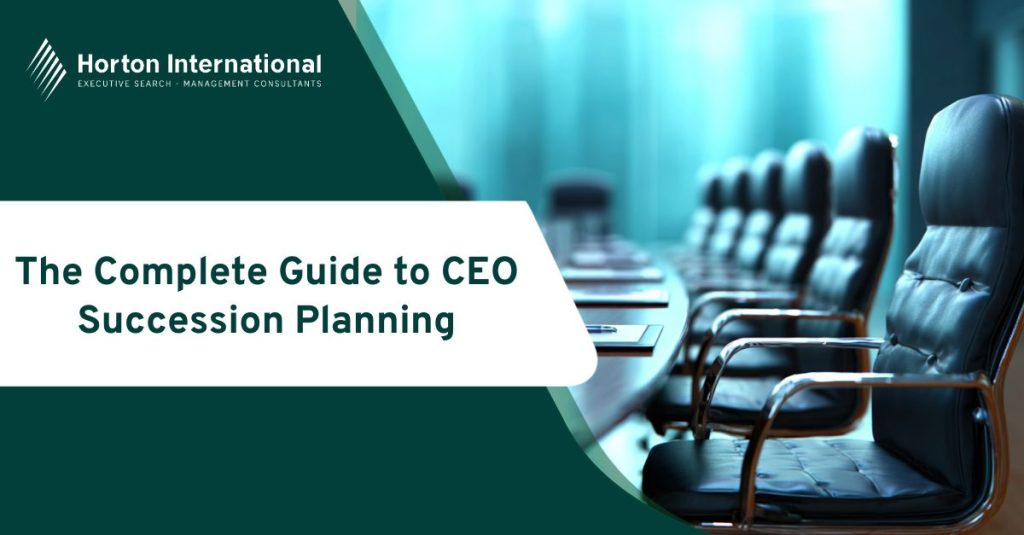What happens when the CEO leaves?
CEO succession planning is a topic that has morphed from a polite annual agenda item, to a pulse-raising priority in many 2025 boardrooms – and it’s a subject that’s gathering more urgency than ever.
There’s a good reason for all this attention – CEO exits have been soaring steadily over the past couple of years. While most are still part of a timely handover, the number of leaders who have been pushed out under pressure has now doubled. According to the S&P 500, 16% of all CEO departures in 2023 fell into this category, the highest number in well over a decade.
Though it’s true some companies do perform leadership transitions with the grace of a well-rehearsed ballet, far too many stumble, sending their share price tumbling into freefall. This can cause shockwaves to ripple through the entire organisation, fracturing the culture and burning through months of strategic planning and momentum.
The difference rarely comes down to luck, it’s almost always about preparation. Solid prep means having robust executive succession planning in place that’s actionable for three potential realities: prep for the planned exits, the unplanned exits, and for sudden emergency CEO successions.
Why leadership transition planning is now a 24/7 job
CEO transition management might sound like the most routine and old-school of all governance duties, a signature here, a bit of paperwork and a “just in case” shortlist. In reality though, it’s a high-stakes, high-speed process that’s becoming increasingly tested in the public eye.
Consider this: in recent years, a growing number of S&P 1500 CEOs have been hired from outside their companies, reaching levels not seen since the early 2000s. The reason for this remarkable increase isn’t because boards fell in love with sourcing outsiders – it’s happening because too many companies lack the internal candidates who are ready to step in.
Simultaneously, leadership pipelines have been shifting alongside this change. CFOs, long seen as dutiful number-crunchers, are now diversifying, staging a comeback as CEO successors.Despite the mounting pressures, only about 50% of corporate boards say they have a written succession plan, while fewer still run annual drills to test out their emergency protocols.
A study of indexes including the S&P 500, FTSE 100 and Euronext 100, revealed that 34% of outgoing CFOs in 2024 transitioned into a CEO type role, up from 20 percent in 2023.
Most boards are much better at planning how to raise more capital than they are dealing with a leadership crisis. But when the CEO makes a sudden departure, organisations can find they have hours – not days – to get it right.
Three kinds of CEO exits – and how to manage them
1 – The Planned Exit
In this scenario the CEO makes clear their intent to retire or step down months, or even years ahead. This is the classic scenario and it’s the easiest to manage, so no wonder it’s the one boards like to imagine will happen every time.
A planned transition offers the company breathing room, giving it time to groom suitable internal candidates, get investor messaging on point, and execute a carefully choreographed handover.
Even so, even a planned exit doesn’t come without risk. In 2024, 59% of new Russell 3000 CEOs and 77% of S&P 500 CEOs were promoted from within yet those figures still leaves a significant percentage where boards opted for outsiders, despite having time to prepare.
2 – The Unplanned Exit
This type is usually the board’s decision – and it’s often triggered by repeated performance failures, cultural breakdowns, or strategic misalignment.
It’s the moment when the chair calls a closed session and the CEO doesn’t walk back into the next meeting. According to CEO Magazine, record numbers of leaders left their roles in 2024 – with 1,991 announcing their departures, the highest figure on record.
Many of these exits are due to internal pressure from activist investors, impatient for results in an increasingly competitive market. Reuters revealed that in 2024, 202 bosses from the world’s largest firms quit their positions, with 43 of those departing due to this kind of pressure.
If they don’t have a credible internal candidate already in the wings, boards can find themselves scrambling, sometimes having to default to an interim leader who lacks the mandate – or the courage – to act boldly.
3 – The Emergency CEO Succession
This is the nightmare scenario for most organisations, where a leader is suddenly incapacitated, resigns without notice, or is forced out following a scandal. There’s no heads up, no farewell memo or stakeholder meeting, only an empty office and an urgent need for continuity.
To counteract this, well-prepared boards will have an interim CEO already identified, vetted, and ready to go. They’ll also have the first 72 hours mapped out, so they can convene the board brief employees, notify regulators and key clients before the markets open, and hold investor calls within a couple of days.
Yet far too few boards have this strategy in place, with many assuming it will never happen to them, until of course, it does. When it does, the difference between prepared and unprepared becomes staggeringly clear – and will very likely be measured in the company’s market cap.
The six-step CEO succession framework
- Define the next leader you’ll need, not the one you have now
Don’t attempt to clone the current CEO. The right successor will be one built for your organisation’s future strategy and planning, whether that will be scaling up AI integration, managing public or activist pressure, or navigating geopolitical supply chain threats.
2. Build support for the next leader’s succession visibly
To thrive, CEOs need P&L responsibility, crisis experience, and face time with the board. If your top candidates are complete unknowns to investors, then they’re not ready yet.
3. Benchmark against candidates outside the organisation
Continuously keep a short list of external talent, not because you’re planning to hire them, but because benchmarking will finetune your internal assessments. Don’t be tempted to skip this step, as investors evaluating your organisation won’t. They will expect you to have looked, especially as the CEO’s performance is pivotal to the success of the entire company.
4. Make the whole process crystal clear
Identify who will run the search for a replacement, how any conflicts will be handled, and how decisions will be communicated. Don’t make the mistake of trying to make these decisions after the CEO is gone, strategise smartly now, so everyone knows exactly what to do when they need to.
5. Have an emergency plan
Don’t wait until the worst happens, name who will be an interim before one is ever needed. Draft up the announcements so they’re ready to go and assign necessary roles – who will inform the bank, regulator, and your biggest customers? Store all of this information securely and make sure it’s regularly updated.
6. Plan ahead so you can onboard efficiently
Appointing the next successor might seem like a monumental challenge but it looks like the easy part compared to what comes next. The real legwork will be done in the first 100 days, when the new CEO will be expected to set the tone, win trust, and prove they are up to the role and can deliver.
The human factor – who will do what when the time comes?
Board Succession Planning – Their central role should be to own the process and protect the business’s interests and investments. In an emergency, they should have the power to name an interim and oversee the narrative.
The CEO as champion – If the original leader is still in place, they should help oversee CEO transition management, champion succession, and most importantly, not be a gatekeeper to power. Top outgoing leaders know to make themselves replaceable long before they plan to leave, so that they make everyone’s job easier when the time comes for their exit.
The Search Committee – This will usually be a subset of the board, whose role will be to facilitate the succession planning process. When it’s time to execute, they’ll handle replacement candidate sourcing and assessments, as well as onboarding. Think of them as the dealmakers but also the referees – if any hitches arise, they’ll be needed to step in.
Getting CEO succession right: What the best companies do differently
- They treat emergency CEO succession and planned or more timely exits as a constant possibility, integrating leadership transition plans into the organisation’s strategy, instead of viewing them as one-off or unlikely events.
- They are transparent about the process, communicating on a need-to-know basis what will happen so that trust is built – but they’re careful not to overshare, or involve players before they are needed. It’s important for companies to be open with employees and investors about their succession plans, but not so open that it encourages rumours, or turns into office politics.
- They rehearse emergencies well ahead of time. Organisations that get CEO succession right are typically the ones that have already prepped, often literally running test drills, so that when the worst does happen, everyone knows what to do and it feels almost routine.
Why does CEO succession planning matter for every company, not just the Fortune 500?
Leaders are crucial to the company and the brutal truth is no company is immune from a CEO exiting, sudden or otherwise. Whether the business is small, medium or large, private, public, or family-run, CEOs can leave on short – or even no notice – in all of them. In an increasingly competitive market, where competence is everything and investors dump stock in seconds, the speed and confidence of the organisation’s response is every bit as important as the chosen successor.
Succession planning isn’t just a dry governance obligation – it’s reputation management, crisis prevention, value protection, and strategy execution all rolled into one. With the issue of CEO succession becoming ever more pressing, organisations shouldn’t merely be asking themselves if they have a plan – but whether or not it will be effective when they need it the most.






